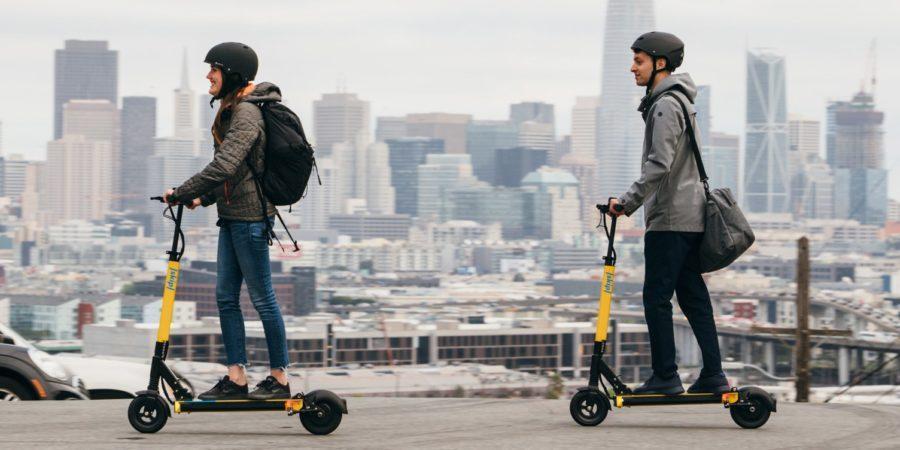- Lime and other dockless bike share companies are pivoting from bicycles to electric scooters.
- Scooter services have outpaced bike share in demand.
- Lime will quietly remove bikes from several cities this month.
In Mountain View, California, home of Google and Microsoft, dockless bike sharecompanies rise and fall in color-coded waves. Spin (orange) dropped out after a short pilot. China-based Ofo (yellow) left town due to financial difficulties. Now, Lime (green) plans to leave by mid-March.
Several cities have reported similar trends. In the space of a month, Lime bikes, which unlock via mobile app and charge riders by the minute, will disappear from the streets of San Mateo, California; Hartford, Connecticut; and an undisclosed number of other cities. In their place, the San Francisco-based startup will offer its popular electric scooter service. Some cities, like Seattle, will see their Lime bicycle fleets transition entirely to electric-assist bikes—while also undergoing a major e-scooter push.
“Lime communicated to us that it’s focusing on scooters now as opposed to bikes,” said Nate Baird, Mountain View’s transportation planner. “They essentially gave us a 30-day notice.”
Dockless bikes and e-scooters fall into the booming “micro-mobility” market, which also includes car sharing, ride hailing, and other shared transportation services. In 2018, the industry saw a flurry of acquisitions, fresh rounds of venture capital, and heated competition between startups.
Lime is only the latest company to embrace an industry-wide shift away from pedal-powered bikes and toward e-scooters. Spin quietly ended its bike share program in April 2018 after expanding into scooters the previous February. Ford bought Spin a few months later, becoming the first legacy carmaker to break into micro-mobility.
China-based startups Ofo and Mobike, meanwhile, pulled out of U.S. cities over the summer after an aggressive global expansion collided with local government efforts to tamp down on unregulated bikes.
Ride-sharing giant Lyft entered the market in 2018, launching e-scooter services in nine cities. It also bought Motivate, North America’s largest bike share operator, in November, acquiring its conventional, dock-based systems.
Lime, which shortened its name from “LimeBike” in August, said the focus on e-scooters is a matter of simple demand.
“Riders are voting with their feet,” a company spokesperson said. “They’ve demonstrated a penchant for Lime’s electric vehicles and shown scooters are no longer a novelty, but rather one more flexible link to the transit chain.”
One study by Populus, a data-management platform for shared mobility services, found that e-scooters had a 3.6 percent adoption rate in 2018 alone. (Docked bike share had a 13 percent adoption rate over eight years.) The report also found greater gender parity in e-scooter use than in bike share—a tempting prospect for cities looking to diversify ridership.
This consensus is trickling down to local officials eager for public data about which transportation services work best.
In Portland, Oregon, riders took more than 700,000 trips on about 2,000 e-scooters between last August and November, according to the Portland Bureau of Transportation. In the same period, riders only took about 134,000 bike share trips.
“I think companies are naturally following the money, and they’re getting more trips out of e-scooters,” said Chris Corrao, senior transit and transportation planner for Cupertino, California, not far from Mountain View. Cupertino is still figuring out what kind of dockless system it wants to adopt, and constant changes in the industry have made it difficult to pin one down.
“We’re disappointed to see more and more companies move away from bikes and into e-scooters,” Carrao said, adding that he while isn’t against scooters per se, he does have concerns about their sustainability. “We’re hearing the devices are only good for 1-3 months,” he said. (Lime would not confirm the average lifespan of its e-scooters, and multiple other scooter companies did not return requests for comment.)
“We strongly believe the best way for us to maximize the positive impacts of Lime in local communities is to demonstrate our agility and willingness to adjust based on patterns of preference, utilization, and needs,” a Lime spokesperson said.
Some cities have seen a public outcry against e-scooters for crowding sidewalks and littering streets. In Cincinnati, an urban design group spray painted designated parking areas for e-scooters to help deal with the problem.
Other critics have raised safety concerns. The Washington Post last fall reported an uptick in emergency room visits due to electric scooters, although the crash data on scooters versus other forms of transportation is still unclear. The CDC is now conducting its first study of e-scooters in Austin, Texas.
And last year, the ride-hailing giant Uber bought stock in Lime as part of a massive private funding round. (Uber also bought Jump, one of the few dockless bike share startups to still see growth with cycling. In October, Jump e-bike rentals outpaced Uber-hailed car trips in Jump’s service area in Sacramento, California.)
Lime said it will keep bike share services in some cities, but would not confirm how many would remain by mid-March. As for what the pivot toward scooters will mean for urban cyclists, planners are taking a wait-and-see approach.
“It’s been a learning experience,” Baird said. “Everyone knows the landscape is changing quickly… All we can do it speculate.”
To read more about bike share we recommend you to read this: Bike share scheme needs a cautious approach
